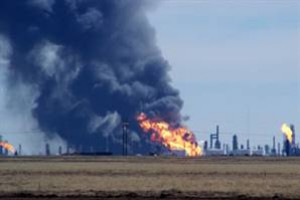At 11:28 pm., a 68 m³ propane tank exploded in a poultry farm, killing 2 volunteer fire-fighters and injuring 7 others. The propane tank fire started after two teenagers driving an all-terrain vehicle (ATV) plowed into unprotected propane piping at the farm. This aboveground piping ran from the propane storage tank to vaporizers, which fuelled heaters located in barns and other farm structures. The 12.8 m long, cigar-shaped storage tank contained propane liquid and vapour under pressure, and the tank was about half full.
The collision severed the liquid pipe and damaged the gas one, triggering a significant propane leak under the tank. About five minutes later, propane vapour leaking from the damaged pipes ignited and burst into flames, engulfing the tank and beginning to heat the propane inside.
Arriving at 11:21 p.m., the firefighters had found the large storage tank engulfed in flames hundreds of feet high. As they could not approach a manual shut-off valve to stop the propane leak, and they decided to let the tank fire burn itself out. The fire chief on the scene believed that in the event of an explosion, fragments would be thrown from the tank’s two domeshaped welded ends. The areas near the sides of the tank, he believed, would be relatively safe. Shortly after their arrival, firefighters approached the sides of the flaming tank and began spraying the surrounding buildings to prevent the spread of fire. Just seven minutes later, the burning propane tank ruptured completely (BLEVE); it was blown into at least 36 pieces, some of which flew 30 m or more, striking buildings and leaving nearly $250,000 in property damage.
The CSB found the initial fire likely could have been avoided by protecting the aboveground propane piping from a motor vehicle collision (fence or barrier). Secondly, the propane system was badly designed :
The ruptured piping was too narrow to allow the flow rate to ever reach the value set for the safety excess flow valve (757 l/min). Thus the excess flow valve never closed and the propane leak continued unabated, feeding the fire until the time of the explosion.
Finally, the CSB determined that better training could have prevented the firefighter deaths and injuries.
Relying on safety videos from the National Propane Gas Association which said that a ruptured tank can and will, most likely, travel in the direction it is pointed and unaware of the danger, they had positioned themselves too close to the sides of the burning tank (the 2 killed were standing 30 m from the tank).




